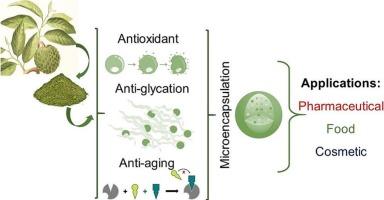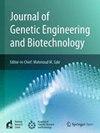Microencapsulation of Annona crassiflora extract using maltodextrin: Material design and evaluation of antioxidant, antiglycation, and antiaging properties in vitro and in silico
IF 2.8
Q3 Biochemistry, Genetics and Molecular Biology
Journal of Genetic Engineering and Biotechnology
Pub Date : 2025-10-07
DOI:10.1016/j.jgeb.2025.100579
引用次数: 0
Abstract
Annona crassiflora, a native Brazilian Cerrado fruit tree, is rich in bioactive compounds, particularly phenolic compounds and flavonoids, known for their antioxidant capabilities. The research addresses the limitations of seasonal fruit production by exploring the bioactive potential of leaves, aiming for sustainable harvesting practices. In view of this, the study aimed to investigate the antioxidant, antiglycation, and antiaging properties of A. crassiflora leaf extract (AcHE), exploring its potential for microencapsulation using maltodextrin. The methodology included the preparation of a hydroethanolic extract (AcHE) from A. crassiflora leaves, phytochemical analysis to determine total polyphenol, flavonoid, and tannin content using spectrophotometric techniques and GC–MS analysis. Antioxidant activity was assessed through DPPH radical scavenging, ferric ion reducing power (FRAP), inhibition of lipid peroxidation (TBARS assay), nitric oxide radical scavenging activity, and oxidative hemolysis tests. Antiglycation activity was evaluated by quantifying free amino groups using the OPA method in a glycation reaction mixture of bovine serum albumin (BSA) and ribose. The study showed the efficacy of AcHE in preventing oxidative stress, glycation, and premature aging, which are linked to chronic diseases. It also demonstrated the optimization of the microencapsulation process with maltodextrin, showing enhanced stability, bioavailability, and efficacy of the bioactive compounds present in A. crassiflora leaves for potential applications in the food, pharmaceutical, and cosmetic industries.

麦芽糖糊精微胶囊化番荔枝提取物:材料设计及抗氧化、抗糖化和抗衰老性能的体外和硅评价
番荔枝是巴西塞拉多地区的一种原生果树,富含生物活性化合物,尤其是酚类化合物和类黄酮,以其抗氧化能力而闻名。该研究通过探索叶子的生物活性潜力来解决季节性水果生产的局限性,旨在实现可持续的收获实践。鉴于此,本研究旨在研究苦参叶提取物(AcHE)的抗氧化、抗糖化和抗衰老特性,并探讨其应用麦芽糊精微胶囊化的潜力。方法包括从草叶中提取水乙醇提取物(AcHE),利用分光光度法和GC-MS分析测定总多酚、类黄酮和单宁含量。通过清除DPPH自由基、铁离子还原能力(FRAP)、抑制脂质过氧化(TBARS试验)、清除一氧化氮自由基活性和氧化溶血试验来评估抗氧化活性。用OPA法定量测定牛血清白蛋白(BSA)和核糖糖基化反应混合物中的游离氨基,评价其抗糖基化活性。该研究显示,乙酰胆碱酯在预防氧化应激、糖基化和早衰方面的功效,这些都与慢性疾病有关。该研究还证明了麦芽糊精微胶囊化工艺的优化,显示了草叶中生物活性化合物的稳定性、生物利用度和功效,在食品、制药和化妆品行业具有潜在的应用前景。
本文章由计算机程序翻译,如有差异,请以英文原文为准。
求助全文
约1分钟内获得全文
求助全文
来源期刊

Journal of Genetic Engineering and Biotechnology
Biochemistry, Genetics and Molecular Biology-Biotechnology
CiteScore
5.70
自引率
5.70%
发文量
159
审稿时长
16 weeks
期刊介绍:
Journal of genetic engineering and biotechnology is devoted to rapid publication of full-length research papers that leads to significant contribution in advancing knowledge in genetic engineering and biotechnology and provide novel perspectives in this research area. JGEB includes all major themes related to genetic engineering and recombinant DNA. The area of interest of JGEB includes but not restricted to: •Plant genetics •Animal genetics •Bacterial enzymes •Agricultural Biotechnology, •Biochemistry, •Biophysics, •Bioinformatics, •Environmental Biotechnology, •Industrial Biotechnology, •Microbial biotechnology, •Medical Biotechnology, •Bioenergy, Biosafety, •Biosecurity, •Bioethics, •GMOS, •Genomic, •Proteomic JGEB accepts
 求助内容:
求助内容: 应助结果提醒方式:
应助结果提醒方式:


